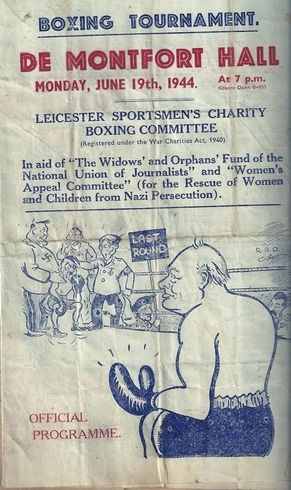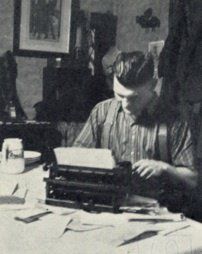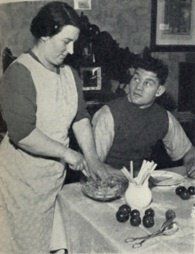
BruceWoodcockBoxer.co.uk
1944 Fight Record
| Date | Opponent | Venue | Result |
|---|---|---|---|
| 04/02/1944 | Tom Reddington | King's Hall, Belle Vue, Manchester, UK | Won - KO - Round 5 |
| 13/03/1944 | Ken Shaw | De Montford Hall, Leicester, UK | Won - TKO - Round 5 |
| 19/06/1944 | Bert Gilroy | De Montford Hall, Leicester, UK | Won - KO - Round 6 |
| 07/08/1944 | Joe Quigley | City Ground, Nottingham, UK | Won - TKO - Round 2 |
| 15/09/1944 | George Marwick | King's Hall, Belle Vue, Manchester, UK | Won - TKO - Round 3 |
| 09/10/1944 | Al Delaney | Circus Street Hall, Nottingham, UK | Won - KO - Round 5 |
1944 - Reputation Growing
If the previous year had been a bit shorter on the fireworks, 1944 was to start and continue with three explosive knock-outs that set the seal on Bruce’s growing reputation as the most exciting young fighter Britain had seen for years. By the end of the year there was no doubt: this man is a contender!
4th February, Woodcock vs Tom Reddington
The eyes of the press had already been set on the future fight between Bruce and Freddie Mills, but Tom Hurst was playing a long game and in no rush to force Bruce on too fast. Instead he chose fights with boxers who had long experience and might help in the build up to such fights.
Tom Reddington had a long career and had already fought Mills three times, winning one and losing two, and, in 1939, he had fought and lost to Jack London, the main contender for the British Empire heavyweight title, left vacant by the retirement of Len Harvey. London would win the vacant title later this same year in a fight against Mills. So Reddington was a key step in the campaign to establish Bruce’s credentials for a shot at the title.
But the Reddington fight proved a chastening reminder that this game was hard. In rounds one and two, Reddington put Bruce down twice for counts of six, for the first time in his career. Bruce learned the lesson and using all his skill to avoid further trouble but fighting ‘savagely’ as one report expressed it, put Reddington down for eight in the fifth and then knocked him clean out in the sixth with a right to the jaw. As R.B. Evans wrote: ‘The way Woodcock rallied from two severe knockdowns to pile-drive his way to victory was little short of miraculous.’ [Archive 1944]. A hard fight but a very valuable one in the lesson it taught and in the status it accrued.
13th March, Woodcock vs Ken Shaw
The eulogies continued in the reports of the next fight at Leicester’s De Montfort Hall. It was against Ken Shaw who was an uncanny Scottish twin of Bruce. Born in the same year, 1920, Shaw was his country’s amateur champion, like Bruce; he had his first professional fight in 1942, the same year as Bruce, and he was so far unbeaten in his professional career, like Bruce. Something had to give!
Some predictions favoured Shaw with his extra stone advantage.
From the start the two men gave everything they’d got in an astonishing display of speed, skill, stamina and power. Henry Rose declared ‘It was the fastest fight I have ever seen between heavy-weights. It started like a whirlwind, and from the first bell until the end of the fifth round they exchanged punches as fast as a clippie during a bus rush hour.’ [Archive 1944] It was nothing short of ‘thrilling’, swinging between the two men evenly for the first three rounds. Then, in the fourth round, Shaw delivered a powerhouse right to Bruce’s jaw, and Bruce had to use all his reserves to hang on and then fight back before the bell went. In the fifth, the fight turned the other way with Bruce catching Shaw with damaging punches that opened a cut around his eye and bloodying his nose; but like, Bruce, Shaw fought on with all his courage, craft and determination to the end of the round, when the referee stopped the fight and declared Bruce the winner.
It was a classic fight and Bruce’s hardest fight, as mentioned in a number of the vivid reports [see Archive 1944].
19th June, Woodcock vs Bert Gilroy
Being fought at the height of the war in the weeks following D-Day, it’s not surprising that the cover for the programme for this bout should have paraded patriotic imagery.
The venue was Leicester’s De Montfort Hall again, against another Scottish champion, Bert Gilroy. For the first time in his professional career, Bruce felt the displeasure of a crowd disagreeing with a decision.
The fight was a good one and both men acquitted themselves well, but in the sixth round, Gilroy went down after a savage right to the jaw. He took his time getting himself together but misjudged it and the time keeper counted ten and out just as he was getting to his feet to continue. The referee, Jack Hart, followed the rule that a boxer must be ready to defend himself by the end of the count, but the crowd disagreed and Gilroy’s corner protested. The result would have been inevitable as Bruce was winning on points and in terms of dominating the fight by that stage, but it soured the atmosphere somewhat.
Still, it was a notable win: just a few months earlier in February, it had taken Freddie Mills eight rounds to dispose of Gilroy. By this time, newspaper boxing correspondents were rating Bruce as third in line to the British crown, after Jack London and Mills, and the prospect of those future confrontations was a matter of growing media excitement.
7th August, Woodcock vs Joe Quigley
This fight was a substitute bout for a scheduled meeting with Canadian heavyweight champion Al Delaney, which had to be delayed until October because of Delaney’s army duties. In his place, Bruce met the Irish boxer, Joe Quigley in Nottingham.
The notable thing about the fight was speed: Bruce finished Quigley off in round two and he did it with a lightning-fast double punch to the chin. For Tom Hurst it was a significant moment. It reminded him of the French boxer Georges Carpentier, who had become European heavyweight champion before the first world war.
15th September, Woodcock vs George Marwick
The fight against George Marwick took place in Manchester’s Belle Vue on the night Freddie Mills boxed Jack London for the British and Empire heavyweight championship, which was vacant after the retirement of Len Harvey. It was the title Bruce had his eye on and, from this performance, he was right. He had Marwick in trouble for three rounds, putting him on the canvas for short counts before unleashing such a powerful punch that the referee stopped the fight after assessing the damage. Meanwhile Jack London took the vacant heavyweight title - but not for long!
9th October, Woodcock vs Al Delaney
The last fight of the year was touted by the boxing correspondents as a key bout in Bruce’s campaign to challenge for the title Jack London now held. Delaney was Canadian heavyweight champion and a boxer with a wealth of experience. Most notably, he had fought world champion Joe Louis ten years earlier and put up an impressive display before Louis beat him in the fourth round. Joe Louis said afterwards that Delaney, (who fought him under his Polish family name of Borchuk), was the hardest fighter he ever came across. Four years later, Delaney beat Jack London, though he subsequently lost to him twice.
In the event, the match lived up to its billing, providing Bruce with his hardest battle so far in what correspondents called ‘the finest fight of his career’. Bruce came out from the start with ‘split second punching’ and ‘snappy two-handed punches to the jaw’, bewildering Delaney with his speed, but Delaney fought back strongly. The second round saw Bruce delivering hard body punches, crosses to the jaw, and swift punches in breakaways. By the fourth, Delaney was groggy and suffering from a cut over his eye. In the fifth, Delaney came hammering out as if the fight had just started, but Bruce took the wind out of his sails with three successive lefts and a right to the jaw. A left and right to the head put Delaney down for a count of nine. When he got up, Bruce pinned him to the ropes, then a heavy body punch and two hard rights to the jaw finished it.
1944 - Summary
So far Bruce had won all of his 19 professional contests, and not one of them had gone further than six rounds - 11 had finished in three!
It was no wonder that commentators were beginning to look beyond Britain towards the far reaches of the world championship. But for now, Bruce had his sights fixed firmly on Jack London and the British title. Encouragingly, in London itself, the wartime authorities had agreed that boxing competitions could resume at the Albert Hall, scene of Bruce’s first professional triumph two years earlier.
Even in the more restricted world of the media in the 1940s, by now, Bruce was the focus of press and fan attention, with profiles in the local paper the Doncaster Evening Post, and fan mail galore, often from the forces battling in the war. But true to his temperament, he continued his life with a quiet determination and when not training, spent his time walking with his Irish terrier Mick and giving P.T. and boxing lessons at Elmfield House Youth Club in Doncaster.


